
Wound Dressings Page Menu: 1 2 3 4 5 6 7 8 9 10 11 Next>>
Wound Dressings in the Golden Age of Piracy, Page 7
Bandages
"Soon after... [the crew of the ship had mutinied and turned pirate], [cook's mate Juan] Ferdinando
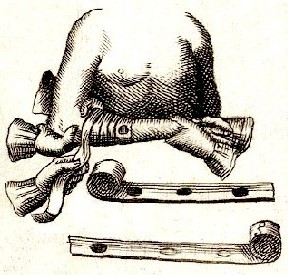
Dressing an Arm Wound part 1, The Chyrurgeons
Storehouse,
by Johannes Scultetus, p. 68 (1653)
presented himself to the surgeon [Charles May] with a bandaged arm that proved to be fractured and gashed. When asked who had applied the dressing, the Indian said a Dutch doctor at Cochin, a port further up the coast. Two other crewmen, Duncan Mackay and Edward Cumming, also needed his skills for injuries. At the time he thought these wounds could have been the result of a fight, but he could not be certain." (Eric J. Graham, Seawolves: Pirates & the Scots, p. 172)
Bandages seem relatively straightforward on the surface. They are things used to wrap and cover wounds. When you look a bit more closely, however, you will see that even today the word takes on several meanings. A bandage can refer to a little pad upon which medicine is applied to a wound, a piece of cloth laid atop pad or a strip of cloth used to wrap them both. Just as we use the word as a catch all term today, so did the surgeons active during the golden age of the pirates.
Pierre Dionis, ever the teacher, takes the explanation of bandages back to basics. "What we
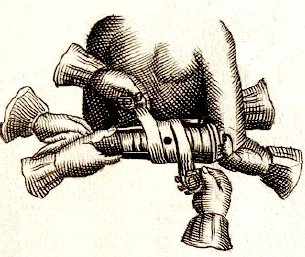
Dressing an Arm Wound part 2, The Chyrurgeons
Storehouse,
by Johannes Scultetus, p. 68 (1653)
call a Band then, is a long and broad Ligament with which we cover and wrap up those Parts which require it, in order to their Re-establishment. Observe then the difference betwixt Band and Bandage, which is, that the Band is, at the same Time, the Instrument and Matter with which
the Bandage is made, and Bandage is the Use and Apposition of the Band."1 By this definition, the pads which cover wounds would not technically be called bandages. Indeed, Dionis and author authors refer to them variously as napkins, compresses and bolsters (the latter two having already been discussed.)
French military surgeon Ambroise Paré broadly divides bandages by purpose, first mentioning those which are "remedies of themselves... whereto the cure is committed, as are these which restore their native unitie, those parts which are disjoined: others are not used for their own sakes, but only to serve to hold fast such medicins as have a curative facultie."2 Each author recognizes that there are several forms and functions covered by the term.
1 Pierre Dionis, A course of chirurgical operations: demonstrated in the royal garden at Paris. 2nd ed., p. 31-2; 2 Ambroise Paré, The Workes of That Famous Chirurgeon Ambroise Parey, p. 358
Bandages: Composition
Just as there are several types of bandages, so there are several materials from which they are made.

Photo: Einsamer Schutze
Linen Dressing - Tomb
of
Herishefhotep
(~2000 BC)
Ambroise Paré divides them into three materials: a) Leather - "of skins, which is accommodated peculiarly to the fractured grisles of the Nose"1; b) Wool - which are "proper to inflamed parts, as those which have need of no astriction"2; and c) Linen- for "when any thing is to be fast bound... some are made of flax, othersome of hemp, as Hippocrates observes."3
Paré goes on to recommend that "linnen is to be made choice of... and judged the best, not which is now and never formerly used, but that which hath already been worn and served for other uses, that so the Bandages made thereof may be the more soft and pliable: yet must they be of such strength that they may not break with stretching, & that they may straitly [tightly] contain & repell the humor ready to flow down and so hinder it from entring the part."4 Thinking along the same lines, Pierre Dionis suggests "Four Qualities... necessary to a Band to render it perfect"5.
"First, that its Matter [composition] be good, that is, if of Linen, that it be neither too old nor too new, that it may be soft, loose and light:
Secondly, that it be clean and well-wash'd, that is may not impress any noxious Quality:
Thirdly, that it be of an even plain Cloth, not wrought, and that it be cut the right way of the Thread, by reason if cut the other way, 'twill slacken and tear; that it be smooth and free from Hems or Knots, as Bolsters are, for fear of giving Pain:
[Fourth] Add also, that it ought to have no Selvage, if we desire the Binding to be completely perform'd.6
In his surgical manual, Paré agrees with Dionis' third point, noting that "the Bandages which are made of
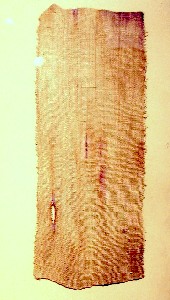
Photo: Einsamer Schutze
Linen Bandage from the
Tomb
of Herishefhotep
(~2000 BC)
Linnen clothes must be cut long-wayes, and not athwart like, and not broader in one place then in another."7
Paré shares some other interesting insights into the proper composition of bandages. He warns the surgeon that they "must not be hemmed nor stitched, must have no lace or seam; for hems and seams by their hardness presse into, and hurt the flesh that lyes under them. Lace, whether in the midst or edges of the rowler, makes the Ligature unequall. For the Member where it is touched with the lace, as that which will not yeeld, is pressed more hard, but with the cloath in the middle more gently, as that which is more lax."8
It may seem a bit unusual to the modern reader to consider making bandages from lace, but when laymen took over the surgical duties from monks in Europe in the 15th century, they still held any operations on man - the image of God - as requiring due reverence. Surgical instruments were often given flourishes so that they were equal to the duty they were tasked with. However, by the golden age of piracy in the 17th and 18th centuries, many of these decorative flourishes had gone away when the surgeons noticed that they tended to get in the way of performing effective healing, as Paré suggests here.
1 Ambroise Paré, The Workes of That Famous Chirurgeon Ambroise Parey, p. 357; 2 Ibid; 3 Ibid; 4 Ibid; 5 Pierre Dionis, A course of chirurgical operations: demonstrated in the royal garden at Paris. 2nd ed., p. 32; 6 Ibid; 7 Paré, p. 357; 8 Ibid
Bandages: Their Forms
Ambroise Paré explains that bandages "differ in figure, for that some of them are rowled up, to which nothing must be sowed, for that they ought to be of a due length to bind up the member: others are cut or divided, which truely consist of one piece, but that divided in the end consist of many branches sowed together, and ending in divers heads, and representing divers figures, such are the Bandages appropriated to the head."1
While Paré touches on the subject of various types of bandages, our master at explaining the varied types of wound applications gives us a more extensive explanation along with a handy diagram. So let's look at Pierre Dionis' comments on the forms that bandages took.
"The first, A, is the Veil or Coverchef, so called, because it covers or wraps round the whole Head: 'Tis made of a Napkin pleated in two Pleats, in order to be put on the Head; and of the four Corners which hang upon the Face, there are two which are ty'd under the Chin, and the other two in the Nape of the Neck; this Bandage is used most of any, and is proper for Wounds of the Head.
The second, B, is the Forehead Cloth: 'Tis of two sorts; one Simple, which is made of a Band turn'd circularly round the Head and the other figur'd, which is compos'd of several pieces or rather foldings of Cloth sewed together, and provided with four Ribbons, at the four Corners, to tie it at the back part of the Head: This Bandage is particular to the Front.
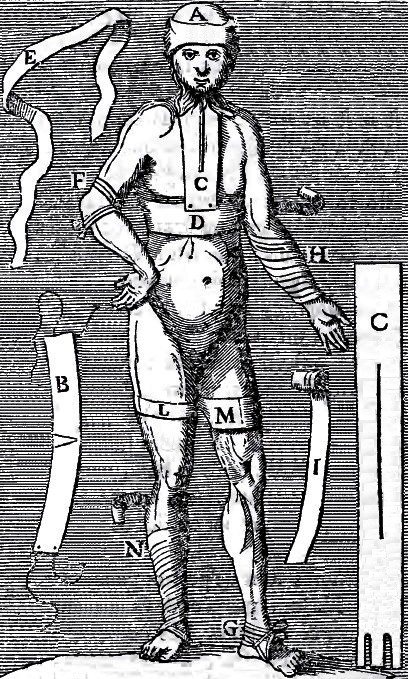
"Of Bandages" Table 7 from Cours d Operations by Pierre Dionis p. 50
The third, C, is the Scapular, so called from its resting on the Shoulders: 'Tis made of a piece of Cloth of two or three Foot long, and seven or eight inches broad: 'Tis cut in the middle in proportion to its length, that it may come over the Head. Use it to sustain all Bandages apply'd to the Breast and Belly. One of the C's shews that out of its place, and the other that apply'd to the wounded Part.
The fourth, D, is the Napkin; we take one of sufficient Length to go round the Body, fold it long-ways three or four times, and with it bind up all Wounds of the Breast and lower Body; 'tis fasten'd behind and before to the Extremities of the Scapular, which prevents its sinking.
The fifth, E, F, G, is a bleeding Ligature; 'tis about an Ell long, and two fingers broad: E shews it you before 'tis us'd; F shews you an Arm after 'tis bound up; and G informs you how to apply a Ligature to the Foot after bleeding, which is called a Stirrup...
The sixth, H, I, is a Bandage for the Arm or Leg, called the Tortile or Winding Bandage; it consists of a Band roll'd up at the end, two or three Fingers broad, and about two Ells long. When 'tis apply'd to the Arm, 'tis begun by a circular Circumvolution of two about the Wrist, and continued to the Shoulder, leaving Spaces betwixt each Round; and when 'tis us'd on the Leg it begins with a Stirrup, the first End being clapt under the Sole of the Foot, and ascending by winding Degrees to the Thigh: This Bandage is barely retentive, its sole Business being to keep the Remedies fixt on the Part. H is one apply'd to the arm; and I shews the Band of which 'tis made.
The seventh, L, is the plainest and most simple of all: 'Tis perform'd with a small short Band, no longer than what is necessary to go once or twice directly round the Part, without either ascending or descending.
The eighth, M, is another retaining plain Bandage; to perform which, a broader piece of Cloth is necessary than the former; 'tis sometimes tied on with small Strings, or else sewed to the Part.
The ninth, N, is a Bandage proper for a Leg, which is to be very tight bound up, and is perform'd with such a Band as the winding or tortile Bandage; the first End is placed under the Sole of the Foot, from whence 'tis roll'd a-cross in such manner, that on the Instep it makes a sort of St. Andrew's Cross; after which, its Circumvolutions are continued to the Knee-Pan: But it must be observed, that, at the
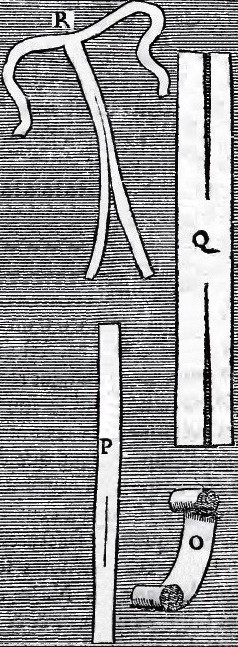
"Of Bandages" Table 7 from Cours
d Operations by Pierre Dionis p. 50
Place where the Calf of the Leg begins, it must be turn'd a-cross; which Course is to be continued 'till it comes to the fullest part of that Member; for otherwise the Bandage would fit hollow, and not keep the Leg equally tight, which is what is necessary.
The tenth, O, is a Band equally roll'd at both ends; 'tis ordinarily apply'd by the middle, each of the Ends being held in each Hand. This Band is broad or narrow, long or short, according to the difference of the Parts, or Sores. It serves to make the Capeline and Splica Bandages in very frequent Use.
The eleventh, P, is a small Band two Fingers broad, and long enough to roll twice about the Part; 'tis slit near one of the Ends, to pass the other through it: This Bandage is called Incarnative, Sarcotick, or Uniting, by reason it re-unites the Lips of the Wound made long-ways, in order to spare by that Means a Suture. This Bandage is begun, by fixing the middle of the Band to the Part opposite the Wound; for Instance, if 'tis to be used for the Forehead, to which 'tis particularly adapted, the middle of the Band must be plac'd on the Occiput, or hind part of the head, and running the two Ends on both sides above the Ears, one end is run or chang'd through the other on the right side of the Wound through the Slit; then drawing both of them, the edges of the Wound are brought to join exactly, that they may unite without any Deformity.
The twelfth, Q, is a Bandage with four Ends, 'Tis made of a Linen Band, whose two Extremities or Ends are length-ways cut in two: When they are cut in three, 'tis a Bandage with six Ends: And when each of them is divided into four, of eight Ends: This Bandage is proper for several Parts. We place it chiefly among the Incarnatives, since it serves to close the Lips of a Wound made a-cross. By the Assistance of these two last Bandages, many Sutures are avoided, from which the Chirurgeon ought to exempt his Patient as much as possible, because they will always, in order to their Cure, prefer their being subjected to the obtuse Sense of a Bandage, to the suffering the sharp Pains of a Suture.
The last, R, is a figur'd Bandage, representing a T; 'tis call'd figur'd, because made of two Bands sew'd together: There are simple or single ones, as this; and others which are slit and double, which are used on several Occasions. This Bandage is adapted to several Parts; 'tis us'd above all in Lithotomy and the Fistula of the Anus."
1 Ambroise Paré, The Workes of That Famous Chirurgeon Ambroise Parey, p. 357;2 Pierre Dionis, A course of chirurgical operations: demonstrated in the royal garden at Paris. 2nd ed., p. 34-6

